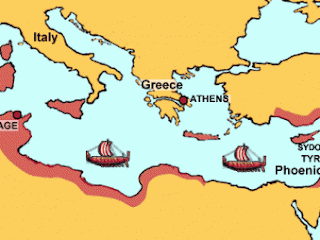 |
| Leptis Magna, Libya |
The first Phoenician colonies were established on North African shores around 1000 b.c.e. The original people of North Africa, surviving to this day in the form of various Berber tribes, strongly defended their territory and freedoms from outside domination.
The geography of North Africa made it easy to mount attacks on settled territory. Vast tribal armies could be hidden in the Sahara to the south. Despite geographic challenges to settlement, there were also irresistible agricultural riches that could be gathered from the coastal plains and valleys of North Africa.
The history of the Roman Empire and the Roman army would have been very different were it not for the breadbasket of Rome that was ancient Libya and North Africa. It provided the "bread and circuses", grain and olives, and wild beasts to the population of imperial Rome and other imperial cities.
  |
The Romans defined ancient Libya as all the lands of North Africa to the west of Egypt. Two thousand years ago the climate of the region was very different. The Sahara did not extend as far north, and there were more regular rains.
Barbary elephants, lions, and apes roamed the forests. The tribes of Libya were not random, disorganized bands of warriors. Most settlement, however, occurred on the coasts where grain and other goods could be easily transported throughout the Mediterranean.
The Romans defeated Carthage in the Battle of Zama in 202 b.c.e., ushering in a new era of Roman colonization of the region. Augustus Caesar for example, granted rich farming territory in North Africa to retired army soldiers and officers. Granting land to veterans also gave them an incentive to defend the empire.
A vast system of mud walls and forts were erected throughout North Africa on the edge of the desert to defend settlers, and hundreds of new Roman cities and villages were established in the coastal plains of Tunisia and Libya.
In cases where it was too difficult to defend Roman territory, regions were given over to local client kings, and pacts of peace were signed. Soon many Africans would become integrated into the Roman system.
Several Roman emperors, including the formidable Septimius Severus were from North Africa. Other famous Roman North Africans included Apuleius, writer of the first classical novel, The Golden Ass, and Augustine of Hippo, the intellectual father of the Roman Catholic Church.
The Byzantines revived Roman North Africa in 533 c.e. after the invasion of the Vandals in 429. Sparked by the revolutionary message of Islam, the Arabs began their rapid invasion of North Africa around 641. Yet the Arabs, like the Romans before them, faced fierce resistance from the native Berbers.
According to legend, the famed Berber queen al-Kahina only surrendered after burning the forests and laying waste to the land. Indeed, centuries after the Arab invasion, cycles of conflict between the Berbers and Arabs, especially in modern Algeria, continue to this day.


































